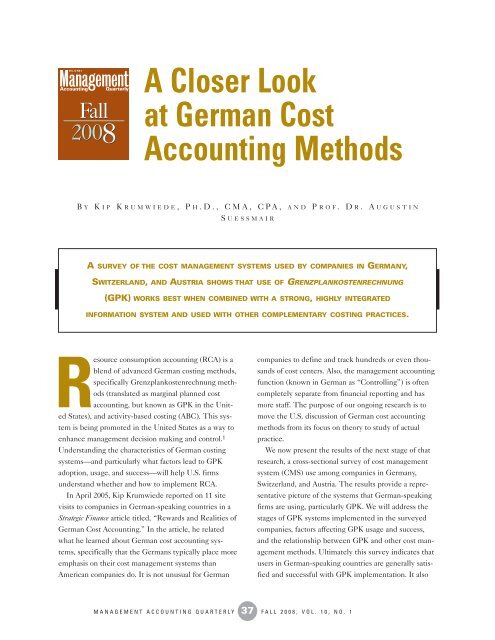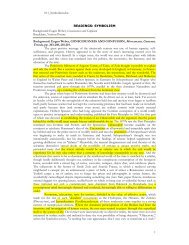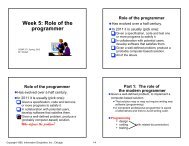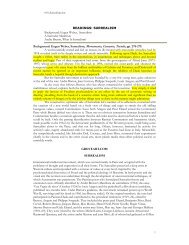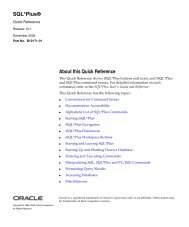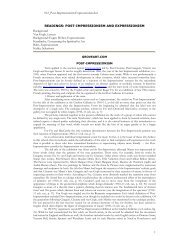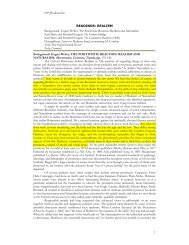A Closer Look at German Cost Accounting Methods - Seeing this ...
A Closer Look at German Cost Accounting Methods - Seeing this ...
A Closer Look at German Cost Accounting Methods - Seeing this ...
Create successful ePaper yourself
Turn your PDF publications into a flip-book with our unique Google optimized e-Paper software.
A <strong>Closer</strong> <strong>Look</strong><strong>at</strong> <strong>German</strong> <strong>Cost</strong><strong>Accounting</strong> <strong>Methods</strong>B Y K IP K RUMWIEDE, PH .D., CMA, CPA, AND P ROF. DR . AUGUSTINS UESSMAIRA SURVEY OF THE COST MANAGEMENT SYSTEMS USED BY COMPANIES IN GERMANY,SWITZERLAND, AND AUSTRIA SHOWS THAT USE OF GRENZPLANKOSTENRECHNUNG(GPK) WORKS BEST WHEN COMBINED WITH A STRONG, HIGHLY INTEGRATEDINFORMATION SYSTEM AND USED WITH OTHER COMPLEMENTARY COSTING PRACTICES.Resource consumption accounting (RCA) is ablend of advanced <strong>German</strong> costing methods,specifically Grenzplankostenrechnung methods(transl<strong>at</strong>ed as marginal planned costaccounting, but known as GPK in the UnitedSt<strong>at</strong>es), and activity-based costing (ABC). This systemis being promoted in the United St<strong>at</strong>es as a way toenhance management decision making and control. 1Understanding the characteristics of <strong>German</strong> costingsystems—and particularly wh<strong>at</strong> factors lead to GPKadoption, usage, and success—will help U.S. firmsunderstand whether and how to implement RCA.In April 2005, Kip Krumwiede reported on 11 sitevisits to companies in <strong>German</strong>-speaking countries in aStr<strong>at</strong>egic Finance article titled, “Rewards and Realities of<strong>German</strong> <strong>Cost</strong> <strong>Accounting</strong>.” In the article, he rel<strong>at</strong>edwh<strong>at</strong> he learned about <strong>German</strong> cost accounting systems,specifically th<strong>at</strong> the <strong>German</strong>s typically place moreemphasis on their cost management systems thanAmerican companies do. It is not unusual for <strong>German</strong>companies to define and track hundreds or even thousandsof cost centers. Also, the management accountingfunction (known in <strong>German</strong> as “Controlling”) is oftencompletely separ<strong>at</strong>e from financial reporting and hasmore staff. The purpose of our ongoing research is tomove the U.S. discussion of <strong>German</strong> cost accountingmethods from its focus on theory to study of actualpractice.We now present the results of the next stage of th<strong>at</strong>research, a cross-sectional survey of cost managementsystem (CMS) use among companies in <strong>German</strong>y,Switzerland, and Austria. The results provide a represent<strong>at</strong>ivepicture of the systems th<strong>at</strong> <strong>German</strong>-speakingfirms are using, particularly GPK. We will address thestages of GPK systems implemented in the surveyedcompanies, factors affecting GPK usage and success,and the rel<strong>at</strong>ionship between GPK and other cost managementmethods. Ultim<strong>at</strong>ely <strong>this</strong> survey indic<strong>at</strong>es th<strong>at</strong>users in <strong>German</strong>-speaking countries are generally s<strong>at</strong>isfiedand successful with GPK implement<strong>at</strong>ion. It alsoMANAGEMENT ACCOUNTING QUARTERLY 37 F ALL 2008, VOL. 10, NO. 1
are the most widely used practices by firms indic<strong>at</strong>ingthey employ the GPK method (see Table 1). Here is alist of GPK practices in order of use by those firms:◆ Using contribution accounting (90%)◆ Analyzing variances by cost center (90%)◆ Using planned (standard) costs for most costingpurposes (77%)◆ Analyzing the consumption (total demand) foreach cost center (71%)◆ Having <strong>at</strong> least one output measure for each costcenter (64%)◆ Separ<strong>at</strong>ing fixed and proportional costs for eachcost center (62%)◆ Assigning indirect costs based on many cost centersand a network of cost assignments (57%)◆ Transferring costs from support cost centers toprimary cost centers while maintaining distinctionbetween fixed and proportional costs (57%)◆ Identifying and computing the cost of idle capacity(49%)These percentages suggest th<strong>at</strong> not all of the GPKpractices are used in each case. Many of the firms surveyedhave simplified and adapted GPK theory to theirown practical needs. For instance, some firms makeassumptions th<strong>at</strong> cost centers are either fixed or variable(i.e., no mixed cost centers). Thus, they do not separ<strong>at</strong>ethese cost types within cost centers.GPK A DOPTERSTo analyze the implement<strong>at</strong>ion of a costing system suchas GPK, two steps are necessary: (1) determining whohas tried GPK (i.e., “adopters”), and (2) identifyingwh<strong>at</strong> stage(s) of implement<strong>at</strong>ion constitutes usage (i.e.,“users”). In the case of GPK, some companies appearto use all the classic GPK practices, but others may onlyuse those they feel are appropri<strong>at</strong>e for their situ<strong>at</strong>ion.Furthermore, two firms may apply essentially the sameGPK practices, yet one might use the inform<strong>at</strong>ion on adaily basis while the other uses it only occasionally. InTable 1, we see th<strong>at</strong> firms identifying their costingmethod as GPK do not all use all of the GPK practices.We also see th<strong>at</strong> firms not calling their costing methodsGPK do use many of the associ<strong>at</strong>ed practices.To define GPK adopters, we conducted site visits tobetter understand why some firms th<strong>at</strong> appear to usemost or all of the GPK practices did not label their costingsystem as GPK. One reason is th<strong>at</strong> some firms associ<strong>at</strong>eGPK with the tool in SAP’s CO moduledeveloped in associ<strong>at</strong>ion with Plaut Consulting. Anotherreason is illustr<strong>at</strong>ed by AVU, a small utility companyin Gevelsberg, <strong>German</strong>y. Thorsten Sebo, head of Controlling,explained th<strong>at</strong> many people associ<strong>at</strong>e GPKwith Wolfgang Kilger, a leading <strong>German</strong> academic inthe field of cost accounting, and, therefore, consider itto be very theoretical. Kilger’s theory is th<strong>at</strong> variablecosts have to be strictly proportional with output, as inthe marginal cost of the last unit (i.e., the Grenzkosten ofGPK). Sebo said th<strong>at</strong> AVU’s system is better describedas Plankosten (planned costs) and is based on an approxim<strong>at</strong>emeasure of activity (e.g., an oper<strong>at</strong>ional measuresuch as hours). This approach is associ<strong>at</strong>ed with HansGeorg Plaut, the former automotive engineer whofounded Plaut Consulting, and is considered morepractical.Another reason is illustr<strong>at</strong>ed by Gebrüder BodeGmbH & Co. KG in Kassel, <strong>German</strong>y, which makesdoors for trains, buses, and cars. Although the companyis essentially doing all the GPK practices addressed in<strong>this</strong> study, its controller said Gebrüder Bode’s costingsystem is not GPK because almost all of its manufacturingis for specific customer orders. His comment was,“GPK cannot be used because we have many differentproduction methods and a lot of small-scale customerprojects.” He explained th<strong>at</strong> bus and train door ordersare generally for 300-500 units, and these may vary bycolor, lighting, fe<strong>at</strong>ures, etc. In his opinion, you cannotdo GPK in <strong>this</strong> situ<strong>at</strong>ion because you cannot planfuture production costs or set standards as you can for amore long-term product.For these reasons, we did not limit identific<strong>at</strong>ion ofGPK adoption to those firms th<strong>at</strong> labeled their cost systemas GPK. Instead, we asked respondents to identifythe implement<strong>at</strong>ion stage th<strong>at</strong> best described theircompany’s situ<strong>at</strong>ion regarding GPK. To define an“adopter” of GPK, we chose the stage, “Implementedthen abandoned” (Implementiert, dann jedoch aufgegeben)or higher. We chose <strong>this</strong> stage even though these firmsabandoned GPK because it means they did try it, butfor some reason (to be analyzed l<strong>at</strong>er in the “user”analysis) the implement<strong>at</strong>ion was not successful or sus-MANAGEMENT ACCOUNTING QUARTERLY 40 F ALL 2008, VOL. 10, NO. 1
usage stages. Here we felt it important to identify someadditional criteria for GPK usage to differenti<strong>at</strong>e it frommere implement<strong>at</strong>ion of some GPK practices. Companiesidentified as “users” in the survey should be applyingthe key practices of GPK systems. 8The Grenzkosten part of GPK implies some form ofmarginal costing, which essentially corresponds to usingproportional costs as product costs. The practice closestto <strong>this</strong> idea tre<strong>at</strong>ed in our survey is addressed in question2b, which refers to contribution accounting (Deckungsbeitragsrechnung).Contribution accounting relies onmarginal costing by subtracting the proportional (i.e.,product) costs from sales. Plankosten refers to planningcosts in every cost center as the result of analytical costbudgeting. Thus, the “plan” part of GPK requires planningthe costs for each cost center. In addition, GPKsystems should separ<strong>at</strong>e fixed and proportional costsand compare planned and actual costs <strong>at</strong> the cost centerlevel. These practices were quite prevalent in firmsidentifying GPK as their cost method (see Table 1),suggesting th<strong>at</strong> in <strong>German</strong>-speaking countries, practicefollows theory fairly closely—certainly closer than in theUnited St<strong>at</strong>es.Thus, to be a GPK user in our study, firms had tomeet the following criteria: (1) use GPK <strong>at</strong> least occasionallyfor decision making, (2) use planned (standard)costs for most costing purposes, (3) analyze variances foreach cost center, (4) use contribution accounting (DB),and, for manufacturing firms only, (5) separ<strong>at</strong>e fixed andproportional costs in rel<strong>at</strong>ion to the output measure foreach cost center. We did not require the last constraintfor nonmanufacturing firms because only about a thirdreported following th<strong>at</strong> practice, and it probably appliesmore to manufacturing firms. Of the 113 adopters, 46firms (41% of the adopters and 16% of all firms) metour definition of GPK user.GPK FIRM C HARACTERISTICSAcademic research on implement<strong>at</strong>ion of new managementsystems shows th<strong>at</strong> actual usage often dependsmore on behavioral and organiz<strong>at</strong>ional issues than oncontextual issues. 9 We compared the 46 GPK users tothe 67 nonusers in several areas. Table 3 shows thecharacteristics we found th<strong>at</strong> differenti<strong>at</strong>e GPK usersfrom nonusers.First, it is commonly thought th<strong>at</strong> companies withERP inform<strong>at</strong>ion systems—and specifically ERP systemsby SAP—are more likely to use GPK costing practices.We cre<strong>at</strong>ed an index of questions to measure thelevel of ERP implement<strong>at</strong>ion th<strong>at</strong> rel<strong>at</strong>ed to mappingout all processes and integr<strong>at</strong>ing the inform<strong>at</strong>ion systemacross sales and oper<strong>at</strong>ions as well as with suppliers anddistributors. Even though GPK adopters have a considerablyhigher level of ERP implement<strong>at</strong>ion than nonadopters,users have an even gre<strong>at</strong>er level thannonusers (+0.65 vs. –0.05; all of our indexes have amean of zero).We also compared groups on overall inform<strong>at</strong>ion system(IS) quality based on an index of questions rel<strong>at</strong>ingto query capability, d<strong>at</strong>a availability, frequency ofupd<strong>at</strong>es, and rel<strong>at</strong>ionship with system vendor. Theresults show th<strong>at</strong> IS quality is also much higher forusers. These numbers add credence to the idea th<strong>at</strong> avery strong inform<strong>at</strong>ion system is important for successfulimplement<strong>at</strong>ion of GPK. As one adopter wrote,“The use of the costing method depends on the ITsystem; hence, it is a question of money and resourceswhich [lead to the] IT system, and subsequently whichaccounting system is used.” GPK users also indic<strong>at</strong>edslightly higher use of ERP systems—particularly thoseby SAP AG—than nonusers, but these percentages arenot st<strong>at</strong>istically different. It appears to be the leveland quality of ERP implement<strong>at</strong>ion th<strong>at</strong> make thedifference.Regarding the amount of money and resources available,we asked all GPK adopters about the nonaccountingemployee and top-management support theyreceived. Top-management support, often an importantdeterminant for successful implement<strong>at</strong>ion of any newsystem, probably has influence over the nonaccountingsupport as well. Both were considerably higher amongGPK users than nonusers. Certainly if upper managementthinks it is important and provides the necessaryresources, GPK has a much better chance of being utilized.One measure of resources provided is the amountof training offered, which was higher for GPK usersthan nonusers, although the generally low scores indic<strong>at</strong>eth<strong>at</strong> more training would have been helpful.Another measure of resources provided is the use ofoutside consultants. Twenty-four percent of GPK usersMANAGEMENT ACCOUNTING QUARTERLY 42 F ALL 2008, VOL. 10, NO. 1
Table 3: GPK User ProfileFirm Characteristic Range Nonadopters GPK Nonusers GPK UsersHigher level of ERP implement<strong>at</strong>ion -2.7 to +2.0 -0.17 -0.05 +0.65 N,AHigher inform<strong>at</strong>ion system quality -3.0 to +1.8 -0.17 -0.03 +0.53 N,ANonaccounting employee support for GPK -1.5 to +2.0 N/A -0.44 +0.42 ATop-management support for GPK -1.8 to +1.8 N/A -0.39 +0.39 AAdequ<strong>at</strong>e training for GPK implement<strong>at</strong>ion 1 to 7 N/A 2.54 3.74 AInvolved outside consultants in GPK system Yes, No N/A 5% 24% AUse budgeting systems for controlling costs 1 to 7 5.84 5.79 6.70 N,AUse benchmarking 1 to 7 4.03 4.05 5.00 N,AUse product profitability analysis 1 to 7 4.78 5.37 N 5.85 N,AUse customer profitability analysis 1 to 7 4.04 4.33 5.39 N,AUse transfer pricing 1 to 7 4.05 4.49 5.31 N,AUse formal str<strong>at</strong>egic planning process 1 to 7 4.87 4.89 5.52 N,AImplement new processes/reengineering 1 to 7 4.96 4.58 5.22 AAverage tenure of CEO (# years) 0-41 6.66 7.24 10.00 AInternal accounting as important as external accounting 1 to 7 4.82 5.28 N 5.38 NControlling and external accounting separ<strong>at</strong>e functions 1 to 7 4.46 4.44 5.73 N,A(Nonmanufacturing firms only)Important for mgt. to have precise answers 1 to 7 5.64 5.55 6.20 N,ANo. of internal cost pools for overhead alloc<strong>at</strong>ion 1-14 4.02 3.63 4.55 A(Mfg. firms only) (4=6-10, 5=11-20, 6=21-50, 7=51-75, 8=76-100)No. of cost centers (Mfg. only) 1-14 6.50 7.90 N 7.52 N(4=6-10, 5=11-20, 6=21-50, 7=51-75, 8=76-100)No. of output measures (Mfg. only) 1-14 4.00 4.95 5.34 N(4=6-10, 5=11-20, 6=21-50, 7=51-75, 8=76-100)Use different cost alloc<strong>at</strong>ion methods for financial Yes, No 32% 28% 59% N,Aaccounting and controllingHigher proportional (variable) cost % 0 to 98% 46% 51% 57% NN = st<strong>at</strong>istically gre<strong>at</strong>er than GPK nonadopters (5% level, two-tailed).A = st<strong>at</strong>istically gre<strong>at</strong>er than GPK nonusers (5% level, two-tailed).responded th<strong>at</strong> outside consultants were involved intheir GPK system, compared to only 5% for nonusers.For an expensive system like GPK to be implementedsuccessfully, it needs to be integr<strong>at</strong>ed with othermanagement systems and practices. Therefore, it is notsurprising th<strong>at</strong> GPK users show higher use of other systemsand practices than nonusers. Besides ERP implement<strong>at</strong>ionand inform<strong>at</strong>ion system quality discussedpreviously, Table 3 shows th<strong>at</strong> users reported higher useof budgeting systems to control costs, benchmarking,product profitability analysis, customer profitabilityanalysis, and transfer pricing. These other practices andsystems probably all benefit from the GPK techniques,and having strong budgeting systems almost certainlyhelps support GPK.In addition, some management practices differenti<strong>at</strong>eMANAGEMENT ACCOUNTING QUARTERLY 43 F ALL 2008, VOL. 10, NO. 1
GPK users from nonusers, such as the stronger employmentof formal str<strong>at</strong>egic planning. One user commentedth<strong>at</strong> GPK is “important for str<strong>at</strong>egic decisions.” GPKstrongly supports str<strong>at</strong>egic decisions such as whether toadd or drop product lines, as well as pricing, outsourcing,etc. Use of a balanced scorecard approach to performancemeasurement was higher <strong>at</strong> user firms, but theoverall mean scores (3.4 vs. 2.6 on a seven-point scale)were so low th<strong>at</strong> it is hard to consider <strong>this</strong> practice a significantpart of a user profile. Similarly, user companieswere more likely to use value-chain analysis thannonusers, but overall these scores were also low. Inaddition, GPK users tend to be those ready and willingto implement new processes or reengineer old ones.Regarding long-term focus, we found the averagetenure of CEOs to be higher <strong>at</strong> GPK user companies(10 years compared to 7.24 years for nonusers). This differencesuggests th<strong>at</strong> these firms focus a bit more onthe long term and may consider their costing system tobe a long-term investment. Our site visits confirmedth<strong>at</strong> <strong>German</strong>-speaking companies generally place muchmore emphasis on management accounting (i.e., controlling)than do firms in the United St<strong>at</strong>es. Indeed,controlling is often a separ<strong>at</strong>e department in thesefirms, and they often have a number of employees dedic<strong>at</strong>edto controlling th<strong>at</strong> rivals the number for financialreporting. Consistent with <strong>this</strong> finding, managementaccounting (or controlling) is an important fe<strong>at</strong>ure ofmost firms in our survey, which correl<strong>at</strong>es with r<strong>at</strong>es ofGPK usage. The average percentage of accountingemployees doing controlling was 50%, and user firmswere slightly higher with a mean of 54%. At nonmanufacturingfirms, we found an even higher likelihood th<strong>at</strong>controlling and external accounting are considered separ<strong>at</strong>efunctions.GPK use is also more likely in firms where, for culturalor market reasons, management wants to obtain preciseanswers to questions, as GPK can provide a muchhigher level of precision than other costing methods.GPK users reported a higher average number of costpools used for overhead cost alloc<strong>at</strong>ion than nonusersdid (around 10 cost pools on average). They also had significantlymore cost centers (around 75 on average) andoutput measures (between 11 and 20) than nonadopters.Users are also more likely to employ different cost alloc<strong>at</strong>ionmethods for financial accounting and controlling(59% compared to 28%), although we found no otherfinancial reporting method to be dominant.Firms with more proportional costs may have agre<strong>at</strong>er need for a control system like GPK, whichrequires more cost centers—and better planning andtracking for each. One nonadopter commented th<strong>at</strong>GPK is “no good [here; because we have] more than90% fixed costs; control with contribution margins, andmanagement performance evalu<strong>at</strong>ion.” The d<strong>at</strong>a supports<strong>this</strong> idea, showing th<strong>at</strong> GPK users have a higheraverage proportional (variable) cost percentage thannonadopters (57% vs. 46%). Surprisingly, we found nomajor differences among user companies regardingprocess flow. User companies include job shop (34%),b<strong>at</strong>ch flow (46%), and continuous flow (20%) firms.Regarding the use of ABC, identified in the survey asProzesskostenrechnung, we found little differencebetween GPK users and nonusers in the use of ABC forcontrolling purposes. Both groups reported using activitycost pools for overhead costs <strong>at</strong> about the same percentage(43%-48%). Thirty-nine percent of GPK usersidentified their costing method as an ABC system,while 30% of adopters/nonusers labelled it as such.M EASURING GPK SUCCESSOf course the big question is whether GPK systemsmake users more successful. Th<strong>at</strong> is always a hard questionto answer because success can be measured inmany ways and is affected by many variables. Still, thestandards for measuring performance are very specificin <strong>German</strong>-speaking companies. Until recently, <strong>German</strong>firms did not even use a general word for “businessperformance” because it was considered too vague.Instead, they would ask, “Wh<strong>at</strong> do you mean byperformance—how is it measured?” These companiesprefer to discuss specific measures of performance, suchas revenue, profits, ROI, total return to shareholder, etc.But in order to better communic<strong>at</strong>e with the Westernworld, <strong>German</strong> companies are increasingly utilizing theEnglish word “performance” to refer to the general performanceof a company.We asked <strong>German</strong> firms to r<strong>at</strong>e the performance oftheir firm and costing system based on several criteria,and then we compared these results with their level ofMANAGEMENT ACCOUNTING QUARTERLY 44 F ALL 2008, VOL. 10, NO. 1
Table 4: Measures of GPK SuccessSuccess Measure Nonadopters GPK Nonusers GPK UsersHow well cost management system (CMS) meetsthe following purposes: (1=poor; 7=excellent)Budgeting and planning 5.75 5.95 6.50 N,APerformance evalu<strong>at</strong>ion 4.55 4.79 5.60 N,AProduct costing/pricing decisions 4.94 4.94 5.47 NExternal reporting 4.84 5.09 5.38 NProcess improvement 4.20 4.63 N 5.09 N,AMake-or-buy decisions 4.22 4.40 4.70Product design decisions 2.81 3.57 N 3.40 NOverall needs 5.21 5.74 N 5.78 NBusiness unit’s performance rel<strong>at</strong>ive to your industry competitorsover the last three years across the following dimensions:(1=signif. below average; 7=signif. above average)<strong>Cost</strong> control 4.89 4.86 5.24 NDevelopment of new products 4.84 4.52 5.19 AInternal process performance 4.55 4.55 4.91 N,AReturn on investment 4.52 4.84 4.84Residual income 4.41 4.81 N 4.81Average gross margin on your business unit’s primary 3.76 3.61 4.33 N,Aproducts/services? (1=0-5%, 3=11-15%, 5=31-45%, 7=61%+)In your opinion, has GPK been worth the cost?Yes/will be N/A 42% 64%No N/A 22% 15%In the future, do you expect your cost accounting system to become:Simpler 28% 24% 35%More complex 43% 43% 37%About the same 29% 33% 28%Do you believe the benefits of GPK have been oversold by GPK advoc<strong>at</strong>es?Yes 27% 18% 18%No 24% 35% 42%N = st<strong>at</strong>istically gre<strong>at</strong>er than GPK nonadopters (5% level, two-tailed).A = st<strong>at</strong>istically gre<strong>at</strong>er than GPK nonusers (5% level, two-tailed).GPK usage (see Table 4). First, we asked them howwell their cost management system (CMS) fulfills variouspurposes. As shown, GPK users r<strong>at</strong>ed their CMSconsiderably higher than did nonusers in almost allareas. Especially noteworthy are the r<strong>at</strong>ings for budgetingand planning (6.50, with 7 being excellent), performanceevalu<strong>at</strong>ion (5.60), product costing/pricing decisions(5.47), and overall needs (5.78).Next, we asked respondents to r<strong>at</strong>e their businessunit’s performance rel<strong>at</strong>ive to their industry competitorsover the last three years according to various measures.As shown in Table 4, users report better cost control,MANAGEMENT ACCOUNTING QUARTERLY 45 F ALL 2008, VOL. 10, NO. 1
development of new products, and internal process performancethan nonusers. In addition, GPK users indic<strong>at</strong>edth<strong>at</strong> their firm’s average gross margin on itsprimary product or service is significantly higher (16%-30%) than did the rest of the respondents (11%-15%).Improved cost control also seems a likely outcome ofGPK practices and could easily lead to higher margins.Responses indic<strong>at</strong>ing better development of new productsand internal process performance suggest th<strong>at</strong> GPKalso facilit<strong>at</strong>es process improvement decisions. Morethan one user commented th<strong>at</strong> GPK aids in sales management,customer analysis, and production decisions(such as when bottlenecks occur).We then asked GPK adopters and users to providetheir opinion about whether GPK had been worth thecost. Table 4 shows th<strong>at</strong> 64% of users indic<strong>at</strong>ed th<strong>at</strong>GPK was either worth it or will be. Only 15% answeredit was not worth the cost. GPK nonusers were a littleless positive, but 42% still indic<strong>at</strong>ed it would be worthit if they used it. Considering the level of workinvolved to implement and maintain the system, thesenumbers suggest th<strong>at</strong> the majority of GPK user firmsfeel it is justified. One user commented, “GPK is a relevantpart of the overall MIS.” Another wrote, “Forshort-term decision making in a goods-producing company,GPK is essential.” On the other hand, not allusers think GPK is worth it. One wrote th<strong>at</strong> GPK was“too expensive (man-hours) to calcul<strong>at</strong>e the r<strong>at</strong>es.”Another adopter wrote, “upd<strong>at</strong>e of system/d<strong>at</strong>a does notjustify the results—cost vs. benefit out of balance.”S IMPLER OR M ORE COMPLEX?There is ongoing deb<strong>at</strong>e in <strong>German</strong>-speaking countriesregarding whether or not cost systems should be simplified,and two general opinions seem to be emerging.One view holds th<strong>at</strong> <strong>German</strong> systems are too complexand need simplific<strong>at</strong>ion; the other contends th<strong>at</strong>because the world is getting more complex, we needmore complex costing systems. Table 4 shows th<strong>at</strong> bothoutlooks are well represented. Considering <strong>this</strong> issuewith reference to GPK use, we can see th<strong>at</strong> nonadoptersand nonusers provided similar responsesregarding the future direction for their CMS. Twentyeightpercent of nonadopters expect it to get simpler,43% said more complex, and the nonuser results weresimilar. GPK users were almost evenly split on theissue, with 35% saying simpler, 37% saying more complex,and 28% saying about the same.I S GPK OVERSOLD BY A DVOCATES?We asked all respondents a question often posed in theUnited St<strong>at</strong>es regarding management accounting systemssuch as ABC: “Do you believe the benefits ofGPK have been oversold by GPK advoc<strong>at</strong>es?” Asshown in Table 4, 27% of nonadopters and 18% of alladopters responded “yes,” while 42% of users (and24%-35% of the rest) answered “no.” Although GPK isintensively taught and discussed in <strong>German</strong>-speakingcountries, it does not appear to suffer from the “hype”th<strong>at</strong> often accompanies consultant-driven tools in theUnited St<strong>at</strong>es.GPK COMPARED TO OTHER COSTINGSYSTEMSIn addition, we compared the success measures of GPKusers with those of firms th<strong>at</strong> employ other costing systems,including “simple GPK” systems, ABC systems,and target costing systems (firms could be included inmore than one c<strong>at</strong>egory). To define “simple GPK” systems,we excluded those th<strong>at</strong> meet full GPK criteriaand included systems th<strong>at</strong> utilize only the most basicGPK practices, contribution accounting and plannedcosts. We included ABC systems because they are considereda key ingredient of resource consumptionaccounting and are currently being promoted in theUnited St<strong>at</strong>es. Finally, although it is not a costing systemby definition, we included target costing as amarket-based pricing and cost management system.As evident in Table 5, the combin<strong>at</strong>ion of GPK andABC consistently provides the best overall CMS andbusiness unit performance results for manufacturingfirms. This group r<strong>at</strong>ed their CMS higher than othergroups for fulfilling the following purposes (all on aseven-point scale): product costing/pricing decisions(6.50), budgeting and planning (6.83), and overall needs(6.67). These firms also r<strong>at</strong>ed their business unit’s performancehigher than the other systems in terms ofreturn on investment (5.60), cost control (5.83), andgross margin on primary products (4.67). We have to becautious in drawing conclusions from these resultsMANAGEMENT ACCOUNTING QUARTERLY 46 F ALL 2008, VOL. 10, NO. 1
Table 5: GPK Success Compared to Other <strong>Cost</strong>ing Systems“Simple GPK + TargetGPK” GPK ABC ABC <strong>Cost</strong>ingSuccess measure 1 Users 2 Users Users 3 Users Users 4Part A: Manufacturing IndustriesTotal number of firms 57 31 23 6 37CMS meets purposes:Product costing/pricing decisions (1-7) 5.88 5.71 5.91 6.50 5.89Budgeting and planning (1-7) 5.88 6.45 5.83 6.83 6.14Overall needs (1-7) 5.69 5.74 6.09 6.67 5.89Business unit’s performance:Return on investment (1-7) 4.55 5.03 4.95 5.60 4.76<strong>Cost</strong> control (1-7) 5.08 5.23 5.14 5.83 5.22Annual sales (1-6) 2.21 1.90 2.26 1.83 2.35Average gross margin (1-7) 4.09 4.20 3.91 4.67 4.15Part B: Nonmanufacturing IndustriesTotal number of firms 30 15 23 6 25CMS meets purposes:Product costing/pricing decisions (1-7) 4.97 4.93 4.62 5.00 5.13Budgeting and Planning (1-7) 6.20 6.60 5.59 6.50 6.40Overall needs (1-7) 5.43 5.87 5.45 6.33 5.84Business unit’s performance:Return on investment (1-7) 4.74 4.43 4.90 4.00 4.50<strong>Cost</strong> control (1-7) 5.10 5.27 4.81 5.17 5.56Annual sales (1-6) 2.33 1.80 2.48 2.50 1.80Average gross margin (1-7) 3.87 4.60 3.62 3.17 3.771 See descriptions in Table 4.2 “Simple GPK” users defined as using planned (standard) costs for most costing purposes and contribution accounting (questions 7j and 2b on Table 1).3 ABC users defined as those th<strong>at</strong> alloc<strong>at</strong>e indirect costs to activity or process cost pools, then assign to cost objects based on multiple cost drivers, andthey named ABC as best describing their costing method.4 Target costing users defined as answering 6 or 7 out of 7 on their usage of target costing over the past three years.because only six manufacturing firms used a combin<strong>at</strong>ionof GPK and ABC, and these varied in industry,sizes, and str<strong>at</strong>egic purpose. The results simply suggestth<strong>at</strong> the GPK/ABC combin<strong>at</strong>ion can be highly effectiveamong manufacturers, indic<strong>at</strong>ing the need for furtherresearch using more and better-m<strong>at</strong>ched firms th<strong>at</strong>would allow for industry-specific analyses.Among nonmanufacturing firms, the story is somewh<strong>at</strong>different. Here the ABC/GPK combin<strong>at</strong>ionreceived the high score for meeting overall CMS needsand was strong in other measures, but the other systemsalso earned high success scores. Target costing usersgave the highest r<strong>at</strong>ing for product costing/pricing decisionsand business-unit cost control. GPK (withoutMANAGEMENT ACCOUNTING QUARTERLY 47 F ALL 2008, VOL. 10, NO. 1
ABC) r<strong>at</strong>ed highest on budgeting and planning andgross margin. ABC was highest on business-unit returnon investment. These groups varied even more thanthe manufacturers in terms of industry and other characteristics,so the results should also be used withcaution.W HEN I S GPK MOST S UCCESSFUL?We also tried to determine the circumstances th<strong>at</strong> makeGPK most beneficial. This is an important question forU.S. firms contempl<strong>at</strong>ing RCA adoption because of thesignificant investment required to implement it. Webased <strong>this</strong> analysis on two measures of success. Thefirst measure is how well the firm r<strong>at</strong>ed its CMS formeeting overall needs. Tables 4 and 5 indic<strong>at</strong>e the averager<strong>at</strong>ings for meeting overall needs among GPK usersand how these compare to assessments of other costingsystems. In Table 6, we split GPK users into twogroups: low and high. The “low” group r<strong>at</strong>ed theirCMS less positively (i.e., 4 or 5 on a seven-point scale),while the “high” group r<strong>at</strong>ed it quite favorably (i.e., 6 or7). As shown, many differenti<strong>at</strong>ing factors were consistentwith the GPK user profile as a whole (Table 3):higher level of ERP and inform<strong>at</strong>ion system quality,benchmarking, transfer pricing (manufacturing firmsonly), and str<strong>at</strong>egic planning generally correl<strong>at</strong>ed withpositive GPK assessment. Also, a few new factorsshowed up, namely use of ABC, Just-in-Time (JIT), targetcosting, and the potential for cost distortions (thel<strong>at</strong>ter two are for manufacturing firms only). Thus GPKTable 6: When Is GPK Most Successful? (based on GPK users only)CMS meets overall needs 1 GPK worth the cost? 2No / Too Yes /Low (4–5) High (6–7) early to tell Will beSuccess Factor (N=11) (N=20) (N=14) (N=10)Higher level of ERP implement<strong>at</strong>ion +0.14 +0.91 L +0.41 +0.64Higher inform<strong>at</strong>ion system quality -0.05 +0.84 L +0.61 +0.24Use benchmarking 4.07 5.47 L 5.17 5.14Use transfer pricing (Mfg. only) 4.00 6.15 L 5.22 5.33Use formal str<strong>at</strong>egic planning process 4.88 5.87 L 5.42 5.43Just-in-Time inventory practices (Mfg. only) -0.15 +0.44 L -0.07 +0.43Potential for cost distortions (Mfg. only) -0.27 +0.32 L -0.06 +0.10Use activity-based costing (ABC) 0% 40% L 25% 24%Use target costing 6% 40% L 25% 29%Nonaccounting employee support for GPK +0.16 +0.55 -0.48 +0.82 NTop-management support for GPK +0.28 +0.45 -0.54 +0.69 NAdequ<strong>at</strong>e training for GPK implement<strong>at</strong>ion 3.50 3.88 2.88 4.11 NImportant for mgt. to have precise answers 5.94 6.33 6.50 5.76 NLow-cost str<strong>at</strong>egy (1 = most important) 5.25 5.34 6.58 4.76 N1 The question was worded as: “How well cost management system (CMS) fulfills the following purposes: Overall needs (1=poor; 7=excellent; all GPKusers indic<strong>at</strong>ed 4 or above)”2 The question was worded as: “In your opinion, has GPK been worth the cost?”L = st<strong>at</strong>istically gre<strong>at</strong>er than “Low” group (5% level).N = st<strong>at</strong>istically gre<strong>at</strong>er than “No / Too early to tell” group (5% level).MANAGEMENT ACCOUNTING QUARTERLY 48 F ALL 2008, VOL. 10, NO. 1
is r<strong>at</strong>ed higher as an overall costing system when thereis a strong, highly integr<strong>at</strong>ed inform<strong>at</strong>ion system andwhen it is used with other complementary costing practicesand systems, such as ABC and target costing.Our second measure of success was whether therespondent felt GPK had been worth the cost. Thisanalysis must likewise be viewed with caution. As illustr<strong>at</strong>edby the range of comments we received on thetopic, opinions about GPK among controllers in <strong>German</strong>yare quite divided, so responses may reflect thebiases of the respondents. The differenti<strong>at</strong>ing factorsth<strong>at</strong> emerged under <strong>this</strong> query are completely differentfrom those prominent in the first measure of success.Here we see th<strong>at</strong> organiz<strong>at</strong>ional factors including nonaccountingemployee support, top-management support,GPK implement<strong>at</strong>ion training, management need forprecise answers, and low cost suggest str<strong>at</strong>egy were st<strong>at</strong>isticallystronger for the “Yes/Will be” group than forthe “No/Too early to tell” group. These findings seemto show th<strong>at</strong> for GPK to be deemed “worth it,” topmanagement has to want it, almost regardless of howwell it meets costing needs.To summarize, there is consistent evidence th<strong>at</strong> GPKusers are quite s<strong>at</strong>isfied and successful when applying<strong>this</strong> advanced costing approach. Yet GPK is r<strong>at</strong>ed higherin meeting overall costing needs when implementedwithin a strong, highly integr<strong>at</strong>ed inform<strong>at</strong>ion systemand when it is used with other complementary costingpractices, such as ABC and target costing. In addition, itis more likely to be deemed worth the cost if top managementstrongly supports it in the organiz<strong>at</strong>ion.SATISFACTION L EVELSThis survey of <strong>German</strong>-speaking firms regarding costaccounting practices and organiz<strong>at</strong>ional characteristicsindic<strong>at</strong>es th<strong>at</strong> GPK users are generally s<strong>at</strong>isfied andhave experienced success with <strong>this</strong> advanced costingsystem. It also shows th<strong>at</strong> certain contextual, organiz<strong>at</strong>ional,and behavioral factors distinguish GPK usersfrom nonusers and the measures of success they report.Users r<strong>at</strong>e the quality of the costing system higherwhen there is a strong, highly integr<strong>at</strong>ed inform<strong>at</strong>ionsystem and it is used with other complementary costingpractices, such as benchmarking, JIT and transfer pricing(for manufacturing firms only), str<strong>at</strong>egic planning,ABC, and target costing. It is more likely to be deemedworth the cost, however, if top management issupportive.How might <strong>this</strong> analysis help U.S. firms in their consider<strong>at</strong>ionof RCA, a blend of GPK and ABC? Althoughbased on a limited number of firms in different industries,the survey provides evidence th<strong>at</strong> <strong>German</strong> manufacturingfirms using both GPK and ABC r<strong>at</strong>e their costsystem and firm performance higher than other firms.The results are less clear among nonmanufacturingfirms, and <strong>this</strong> sector needs to be researched further.The results for manufacturers suggest th<strong>at</strong> RCA canprovide the best fe<strong>at</strong>ures of both GPK and ABC. Thisstudy also indic<strong>at</strong>es a number of important issues th<strong>at</strong>firms should take into account before adopting RCA.Above all, they should consider whether they have thecomplementary systems and top-management supportnecessary for success. ■Kip Krumwiede, Ph.D., CMA, CPA, is an associ<strong>at</strong>e professorof accounting <strong>at</strong> Boise St<strong>at</strong>e University in Boise, Idaho.You can reach Kip <strong>at</strong> (208) 426-2288 orkipkrumwiede@boisest<strong>at</strong>e.edu.Prof. Dr. Augustin Suessmair is a professor of str<strong>at</strong>egicmanagement and control <strong>at</strong> the University of Lueneburg.You can reach Augustin <strong>at</strong> (+49) 4131-677-743 orsuessmair@uni-lueneburg.de.E NDNOTES1 For example, see Kip Krumwiede and Augustin Suessmair,“Getting Down to Specifics on RCA,” Str<strong>at</strong>egic Finance, June2007, pp. 50-55; Gunther Friedl, Hans-Ulrich Küpper, andBurkhard Pedell, “Relevance Added: Combining ABC with<strong>German</strong> <strong>Cost</strong> <strong>Accounting</strong>,” Str<strong>at</strong>egic Finance, June 2005, pp. 56-61; and Anton van der Merwe and David E. Keys, “The Casefor Resource Consumption <strong>Accounting</strong>,” Str<strong>at</strong>egic Finance, April2002, pp. 31-36. There is even a new RCA Institute(www.rcainstitute.org).2 The low percentage of usable responses is a limit<strong>at</strong>ion of <strong>this</strong>study and is probably due to the frequent survey requestsreceived by members of the ICV and the length of the survey(43 questions). Almost all respondents are from controlling oraccounting areas.3 See Wolfgang Kilger, Jochen Pampel, and Kurt Vikas, “Chapter0, Introduction: Marginal <strong>Cost</strong>ing as a Management <strong>Accounting</strong>Tool,” Management <strong>Accounting</strong> Quarterly, Winter 2004, p. 15.Reprinted and transl<strong>at</strong>ed from Kilger, Pampel, and Vikas, FlexiblePlankostenrechnung und Deckungsbeitragsrechnung, 11th edition,GmbH, Wiesbaden, <strong>German</strong>y, 2002.4 See Friedl, Küpper, and Pedell, June 2005; Kip Krumwiede,MANAGEMENT ACCOUNTING QUARTERLY 49 F ALL 2008, VOL. 10, NO. 1
“Rewards and Realities of <strong>German</strong> <strong>Cost</strong> <strong>Accounting</strong>,” Str<strong>at</strong>egicFinance, April 2005, pp. 27-34; and Paul A. Sharman, “Bring on<strong>German</strong> <strong>Cost</strong> <strong>Accounting</strong>,” Str<strong>at</strong>egic Finance, December 2003,pp. 30-38.5 See Friedl, Küpper, and Pedell, June 2005; and Sharman,December 2003.6 Studies include R.B. Cooper and R.W. Zmud, “Inform<strong>at</strong>ionTechnology Implement<strong>at</strong>ion Research: A Technological DiffusionApproach,” Management Science, vol. 36, no. 2, 1990, pp. 123-139; and Kip Krumwiede, “The Implement<strong>at</strong>ion Stages ofActivity-based <strong>Cost</strong>ing and the Impact of Contextual and Organiz<strong>at</strong>ionalFactors,” Journal of Management <strong>Accounting</strong> Research,vol. 10, 1998, pp. 239-277.7 Paul Sharman and Kurt Vikas, “Lessons from <strong>German</strong> <strong>Cost</strong><strong>Accounting</strong>,” Str<strong>at</strong>egic Finance, December 2004, pp. 28-35.8 To identify key practices of GPK systems, we relied primarilyon two sources. The first is the Controller-Wörterbuch (or Dictionaryfor Controllers), Intern<strong>at</strong>ional Group of Controlling [IGC],Schäffer-Poeschel Verlag, Stuttgart, <strong>German</strong>y, 1999. It is a helpfuldictionary for <strong>German</strong> controllers, providing both <strong>German</strong>and English transl<strong>at</strong>ions. The second source is Friedl, Küpper,and Pedell's June 2005 Str<strong>at</strong>egic Finance article.9 Cooper and Zmud, 1990; and Krumwiede, 1998.MANAGEMENT ACCOUNTING QUARTERLY 50 F ALL 2008, VOL. 10, NO. 1


